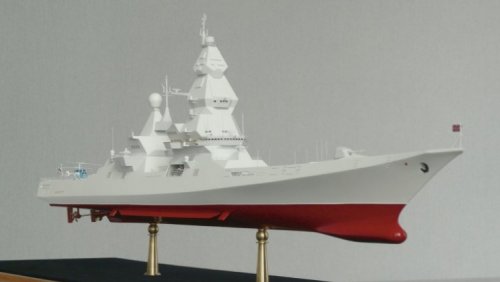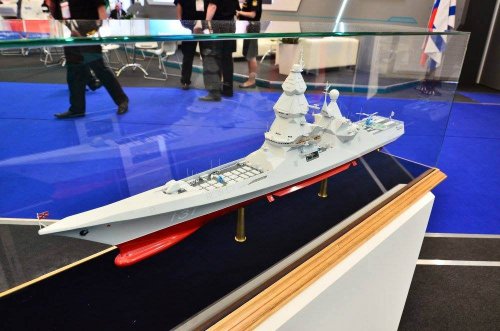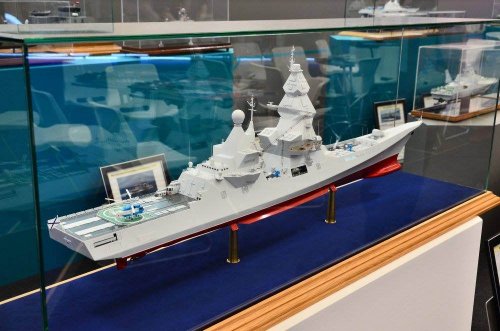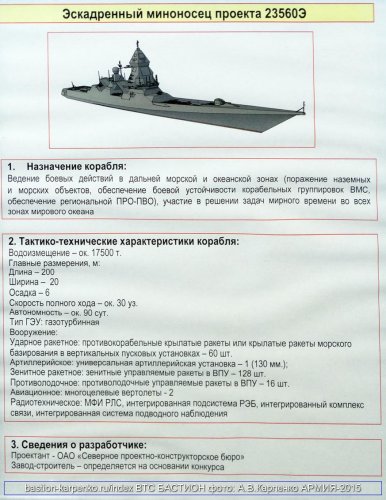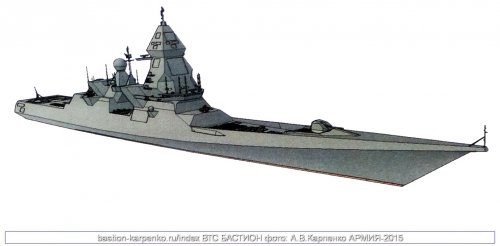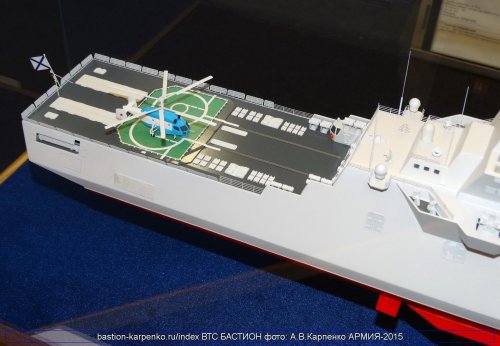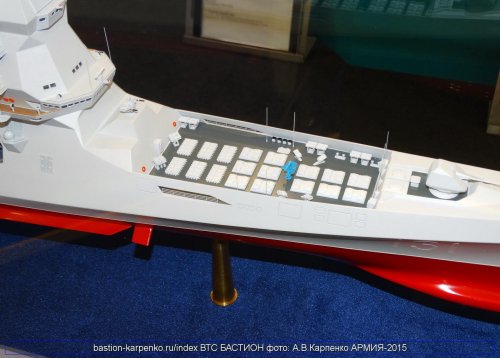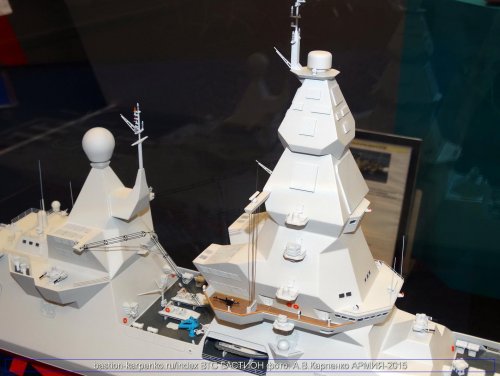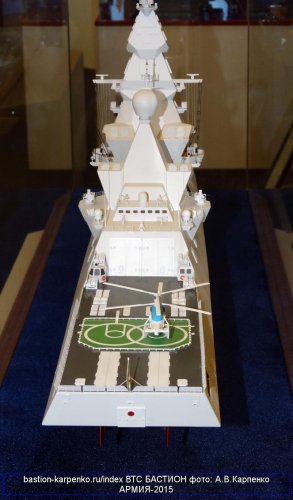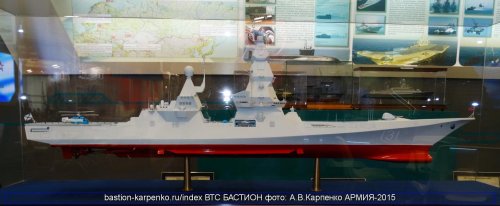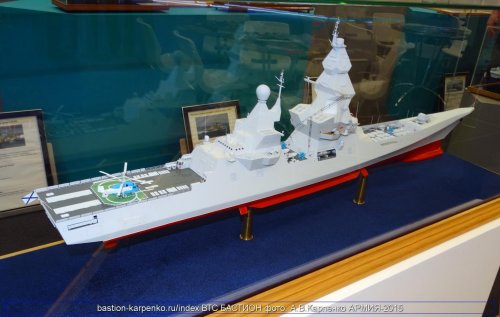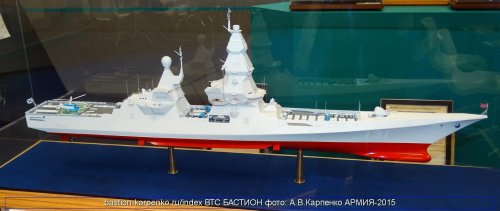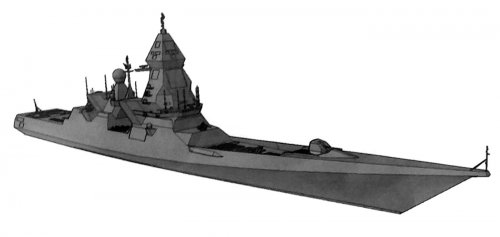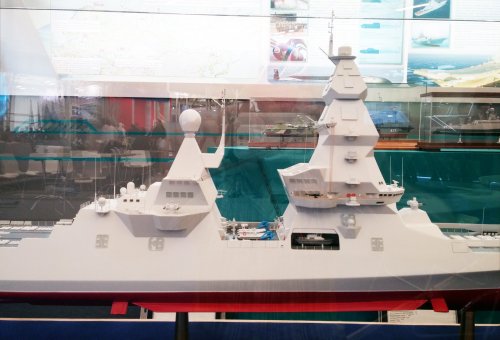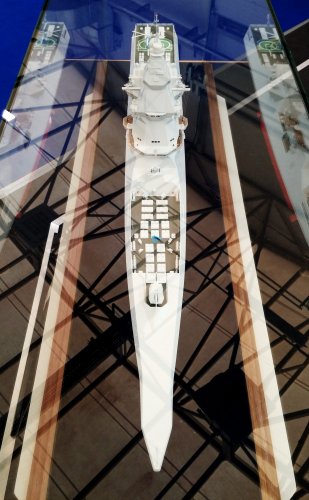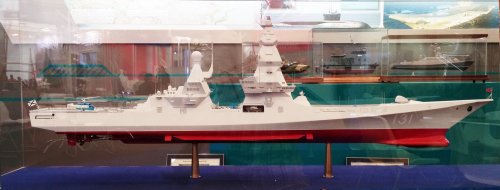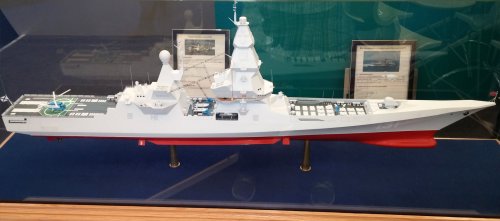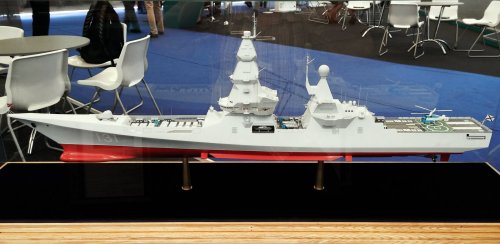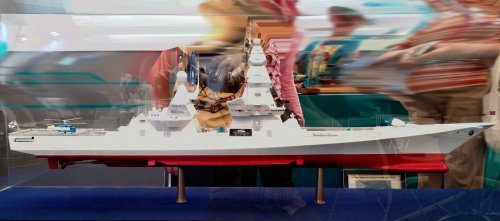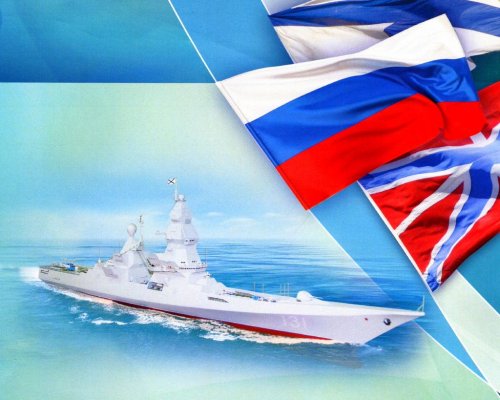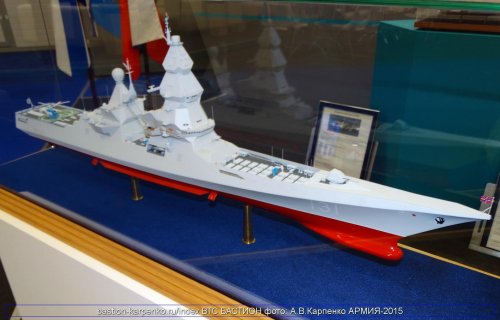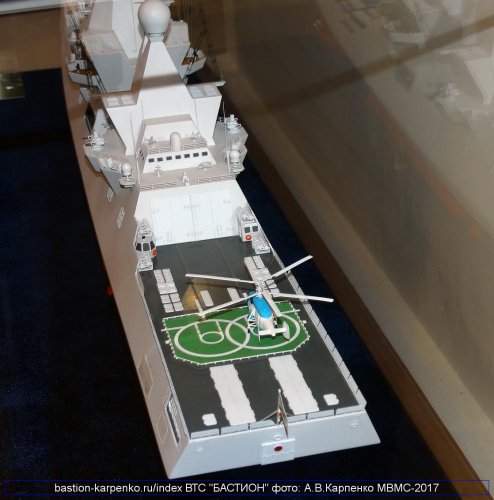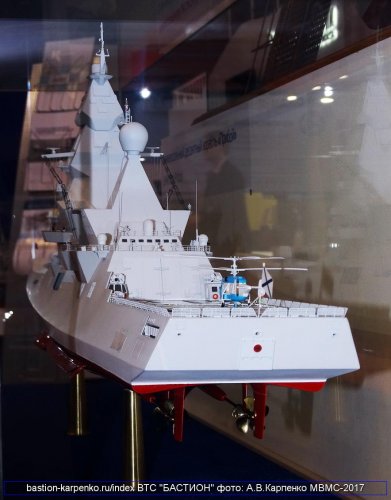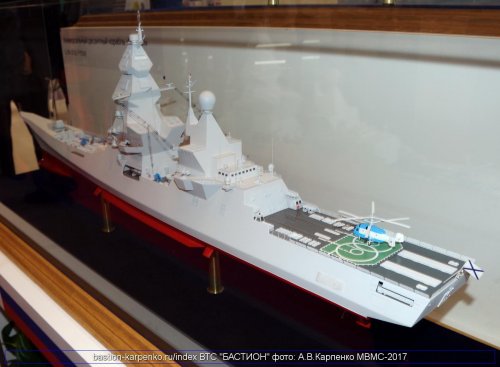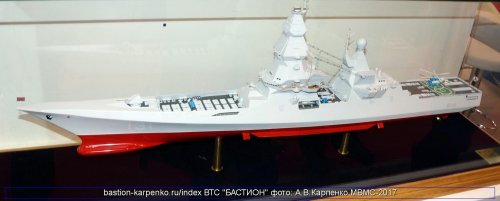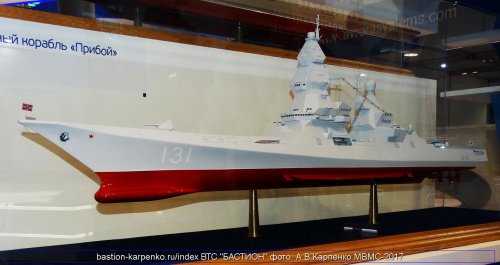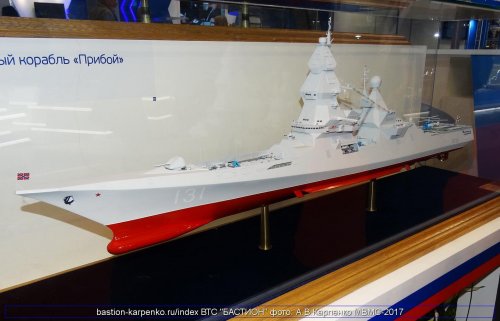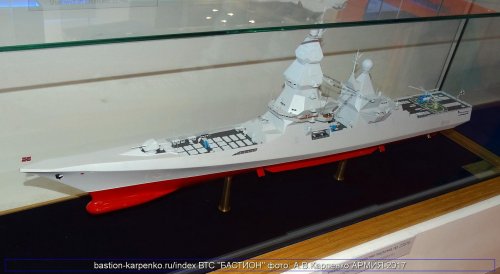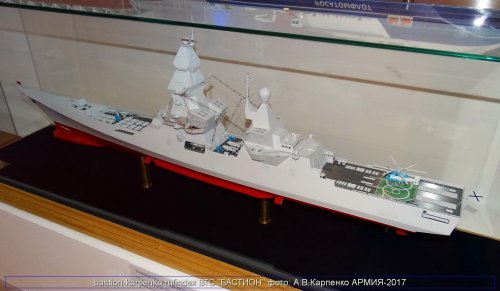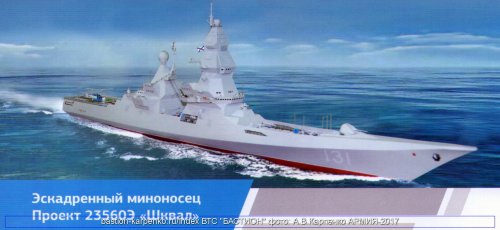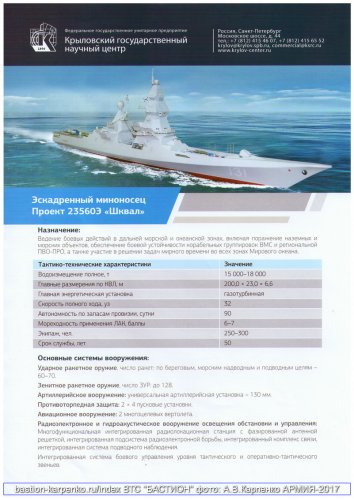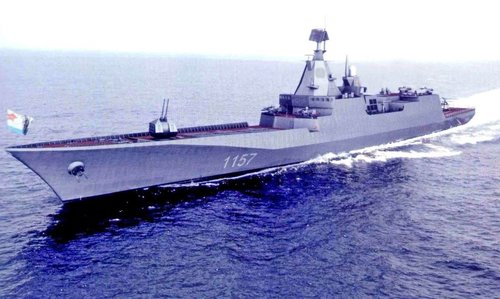Project 23560E Shkval (squall) is the Russian Navy's current design for their next class of cruisers. It was publicly unveiled in March of 2015, and has been a media sensation ever since. It is the product of a mid-2000s plan by the Russian Navy to replace or radically modernise all of their major surface combatants by 2027.
The appearance of the project Shkval is quite intimidating, to say the least, with extremely angular features, a towering superstructure, a pyramidal aft mast, and a monolithic conning tower with three tiered, diamond-shaped bulges; both superstructures are also heavily clustered with platforms and balconies for sensors, communication systems, searchlights, and possibly weapons. Two canted and angular funnels are mounted side-by-side on the aft end of the conning tower.
The bow is subtly raked, with a raised forecastle topped with a single gun turret, and spray shields on either side of the lower forward deck, which is covered with VLS launch cell hatches. Spray shields also cover the edges of the deck between the fore and aft superstructures, which also features boats and various raised fixtures. A shorter spray shield extends partly behind the aft end of the aft superstructure, which contains a helicopter hangar. The long fantail is topped with a sizable helipad, and ends in a transom stern. The keel boasts a sizable bulbous bow, four large stabilizers, and extremely long and broad chines to provide enhanced stability; no doubt to compensate for the topweight of the colossal conning tower.
Little has been mentioned thus far about the planned electronics suite of the project Shkval. The model clearly depicts one large and two small spherical radomes, and what appear to be panels for AESA radar and a bulbous bow that may contain a sonar system. Similarly, no information has been provided as to the propulsion, speed, or range the project Shkval is to have.
Given the overwhelming size, technology, and firepower of the project Shkval, its official designation as destroyer is arguably a misnomer, given that it generously exceed the power of most cruisers. Most likely that designation destroyer was given due to political reasons. Once operational the new class of cruisers would replace the Kirov class and Slava class warships, that are steadily approaching the end of their service life.
More than 200 missiles are to be carried, including 70 cruise missiles, 128 Surface-to-Air Missiles (SAMs), and 16 anti-submarine missiles, along with a 130-mm gun and 2 helicopters. The sheer size of the design is equally imposing, at 200 m long, 15 000 tons at standard displacement, and 18 000 tons with a full load. The shape and composition of the Shkval are meant to reduce their radar cross-section to a minimum, while advanced sensors are meant to scan the seas, skies, and depths for threats at great distances, and a combat information system on par with the West's Aegis is meant to coordinate all of this.
The Shkval is specified to be powered by gas turbine engines and make 32 kts, though no other details concerning the vessel's mobility have been released to the public. It is also unknown what the projects' maximum range is to be, although it is planned to carry enough stores for an endurance at sea of 90 days. The vessel is to be propelled by 2 screws, and the steering equipment includes two large, trapezoid-shaped rudders.
Jane's has noted that while the Shkval is meant to be powered by gas turbines, Russia no longer has the ability to manufacture naval gas turbine engines of the scale required to power an 15,000-ton warship. Of even greater concern is that Russia also no longer has shipyards capable of manufacturing a 15 000-ton warship, which in earlier years resulted in the undoing of a Russian Navy 2007 plan to commission 6 new aircraft carriers by 2027.
However, there are other visible issues with the Project 23560E Shkval design, which beg the question of whether the Russian shipbuilding industry is actually capable of delivering such a monumental vessel; and also the judgment of the Russian Navy's leadership, for having wedded the Navy to the design in the first place.
A major concern for the project Shkval is icing in sub-zero weather and rough seas. Inattention to this issue in the Soviet era notably resulted in one class of warships having a severe operational deficiency. The Kynda class cruisers in the early 1960s had extremely tall and complex pyramidal masts, that not only had excessive topweight to begin with, but also gathered so much ice in arctic weather that the Kyndas were deemed too dangerous to operate in the Arctic Ocean. As a result, the Kynda class had the grim distinction of being the only Soviet cruisers that never served in the Arctic with the elite Red Banner Fleet. If the plight of the bygone Kynda class is any indication, the monolithic triple-diamond main mast of the Skhval is certain to experience the same problems.
Another questionable feature is the prominent boathouse at the base of the conning tower. Such large cavities (to say nothing of the whale boat inside) are extremely powerful radar reflectors, which makes minimizing radar cross-section impossible. Though this problem would be greatly mitigated by covering the boathouse with a door or shutter, no such feature was visible on the models, nor described by the designers.
There are also viable discrepancies between the layout of the design and its claimed capabilities. The Russian Navy claims the Shkval will carry 132 SAMs, 60-70 land-attack cruise missiles, 16-24 anti-submarine missiles, but scale model upon close inspection has only 72 VLS launch cells, and no visible box launchers. If it does indeed carry so many missiles with so few launch tubes, the rate of fire will be markedly slower than that of Western Aegis destroyers. Moreover, as a VLS launch cell ordinarily holds only one missile (for survivability reasons, as it helps contain a missile fire or "cook-off", and also because of the impracticality of having a magazine that loads so many different missile tubes), it is questionable whether carrying more than 72 missiles is feasible. This discrepancy has yet to be explained by either the designers or the Russian Navy.
The launch cells on the Shkval are also poorly-sited, with most of them being set forward, and there are noticeably less of them than on many contemporary Aegis warships, and and they're seemingly scattered randomly all over the recessed area of the forecastle (compare to all the VLC cells on the Sejong the Great class being packed into two neat, small squares). No other missile launchers are visible on the model. There is also no mention or visible evidence on the scale model made of anti-submarine rocket launchers or a torpedo battery, even though these have both been staples of Soviet and Russian warships since the 1950s.
Even though their helipads only cover a small portion of the deck, they are far too large for a vessel expected to operate one or two helicopters, and the hangars on the Project 23560E Shkval model are too small to hold more than that many.
It is also doubtful that Russia could afford to build even one of these vessels, regardless of whether their infrastructure is capable of it, as each would easily exceed $10 billion in cost; even comparatively wealthy Western nations can't afford to sink so much money into a warship. The US Navy is already learning the hard way with the Zumwalt class destroyers, which each cost more than twice as much). As with so many other huge weapons so publicized throughout Russia's history, such as the Tsar Cannon, the Tsar Tank, the Tsar Bomb, and recently the much-publicized "Father Of All Bombs", this new warship design is more likely an exercise in posturing, rather than a design intended to actually be put into production. Project 23560E Shkval could well be remembered in the future as the "Tsar Destroyer".
Whether these issues can be resolved (or at least mitigated) has yet to be seen.

